 |
 26-Mar-2019, 12:53 AM
26-Mar-2019, 12:53 AM
|
#1
|
|
Antenna Enthusiast
Join Date: Mar 2016
Location: Beach Park IL
Posts: 318
|
2 CM4228's combined?
Hi all,
I would like feedback from all members here!
I live near the Wisconsin border, still in Illinois, 39 miles north of Chicago and 46 miles south of Milwaukee. Here in Illinois, it's not so common to see rooftop or towered antennas. I guess we got cable several years earlier than WI or is it that the Chicago market was/is more desirable than Milwaukee and less people had rooftop antennas and just let them got to hell and junked them on the next re-roof?
Anyhow, I'm kind of an antenna spotter.
Just across the state line is Kenosha WI. Antenna-town USA.
Kenosha is former home of Nash then Rambler, AMC and then Chrysler. And Kelvinator AMC refrigerator division. All are gone now. Snap-on tools has worldwide headquarters there. 100,000 strong, mostly single residence. Lot's of antennas.
Anyhow, Kenosha has the most antenna towers I've ever seen. It's like an outdoor antenna museum, stuff from the 50's, most still aimed in the proper orientation either towards Chicago or Milwaukee. I see a lot of old antenna pairs also opposed, pointed at either city. I always wonder how well they work. My luck with combing antenna was very spotty.
Lately, as I gaze skyward have been seeing a hell of a lot of 8 bay antennas, very shiny, a lot are new, doubled up and set up in opposed directions. This must be working for my area.
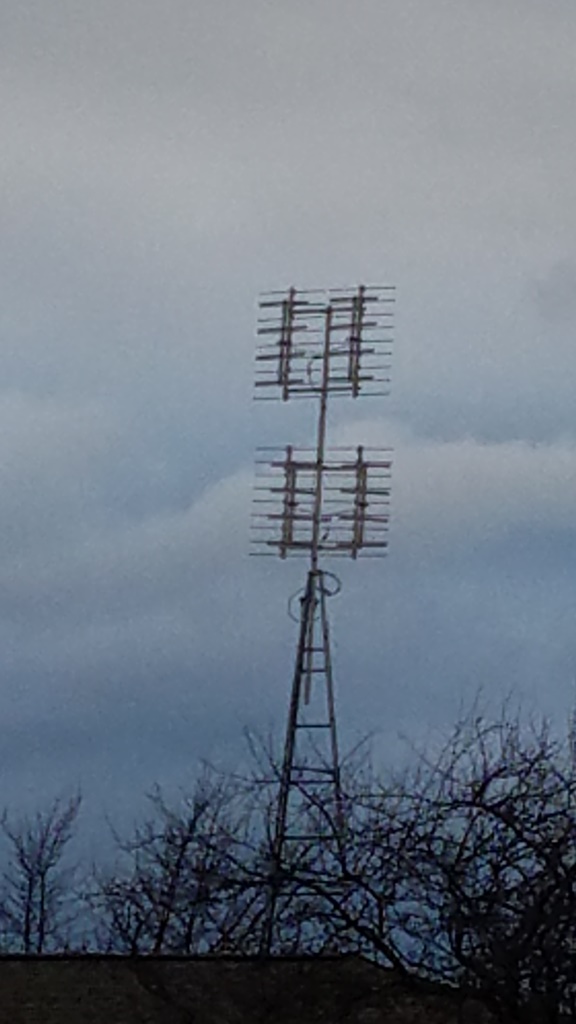
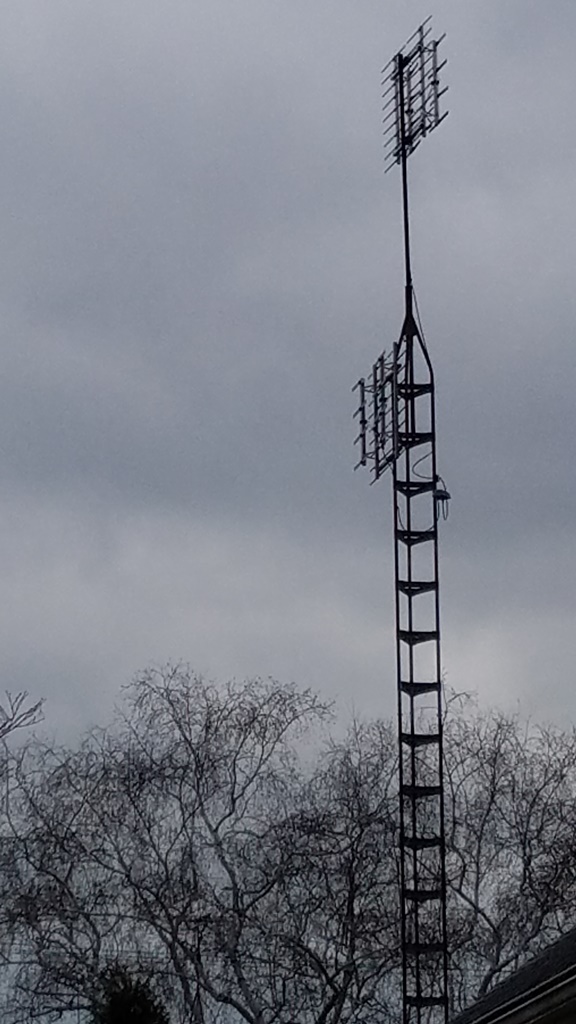
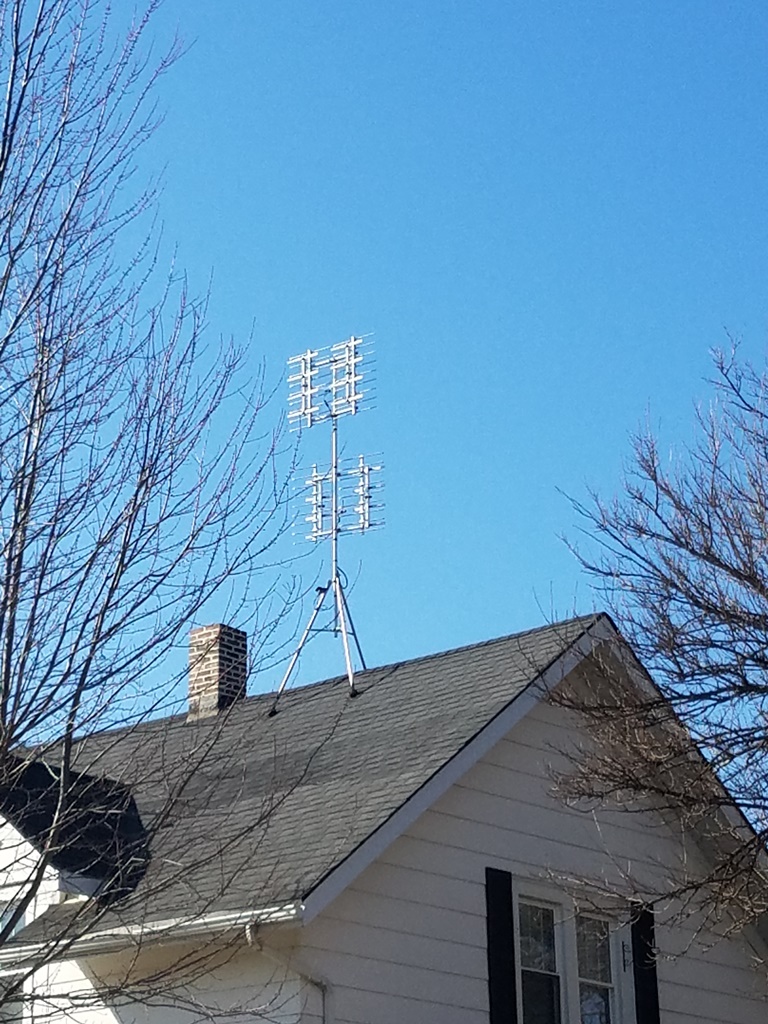
So, here's my question, as I may ultimately do something similar.
Even though these are matching antennas I wonder what luck they have by combining them? Or are they? Maybe separate inputs at the TV?
Why not just remove the reflectors and get both directions since Chicago is 168 south and Milwaukee 353 north? This almost 180 degrees opposite.
Just think, in a perfect world they could remove the reflectors, combine the antennas and increase the strength.
I also see this combination a lot, the famous "crazy 8's" as I call them, the C4 & C4-Max:
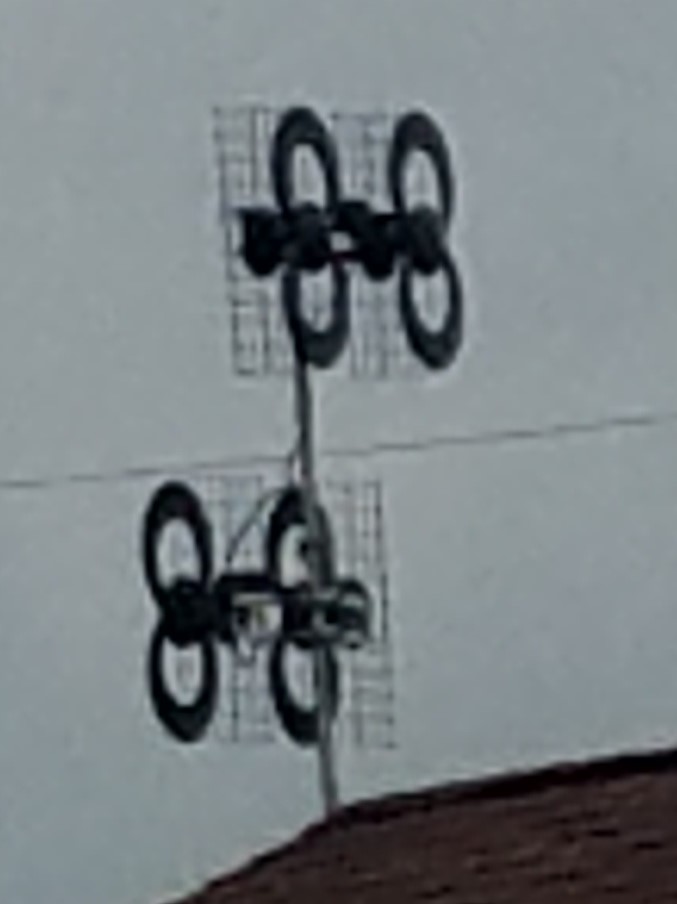
Here's a typical TV Fool report for the area:
http://www.tvfool.com/?option=com_wr...903811d4bb07df
Any opinions?
Last edited by bobsgarage; 26-Mar-2019 at 3:04 AM.
Reason: More boring details.
|

|

|
 26-Mar-2019, 12:49 PM
26-Mar-2019, 12:49 PM
|
#2
|
|
Senior Member
Join Date: Mar 2017
Posts: 413
|
Greetings from Arizona Bob,
Combining two UHF antennas pointing in opposite directions is a
hit or miss proposition. Usually, one or more signals gets cancelled
out. Best success would be accomplished with two UHF antennas
WITH reflectors and two separate RG6 cables to each television.
Use an A/B switch or a second tuner at the televisions to watch either
Milwaukee or Chicago. We have very weak signals here, mostly translators,
at nearly 180 degrees opposite. I've yet to view any antennas with no
reflectors or two UHF antennas pointed in the opposite direction. They
just do not work that well.
|

|

|
 26-Mar-2019, 1:26 PM
26-Mar-2019, 1:26 PM
|
#3
|
|
Antennas Direct Tech Supp
Join Date: Jan 2010
Posts: 2,942
|
Joe's suggestion regarding two antenna systems is the one most likely to work best but will come with a level of either expense or inconvenience that may make that option less desirable to many users.
Quote:
Why not just remove the reflectors and get both directions since Chicago is 168 south and Milwaukee 353 north? This almost 180 degrees opposite.
|
I've recommended that option for your area for years for the UHF stations with very good results.
For locations that are nearly opposite each other and there are no co-channel conflicts, I've advocated for the choice of the bidirectional reflector-less option versus the "combined-two-antenna" configuration for quite some time. Barring potential multi-path concerns, it simply works better. It offers higher net gain by around 3 dB which improves system noise figure and completely avoids the pitfalls of trying to combine two antennas by avoiding phase cancellation. It also costs less than half of the two antenna option.
The two-antenna option combined via a reversed splitter suffers a theoretical 6 dB hit in gain over the gain of the individual antennas. A reflector-less version of one of those same antennas only experiences a reduction of up to 3 dB of the gain of the unmodified antenna in its primary lobe.
This is a not a one-size-fits-all proposition, though. There are times when the two-antenna option is the better choice.
Last edited by ADTech; 26-Mar-2019 at 4:43 PM.
|

|

|
 26-Mar-2019, 3:09 PM
26-Mar-2019, 3:09 PM
|
#4
|
|
Retired A/V Tech
Join Date: Aug 2012
Location: S.E. VA
Posts: 2,750
|
Quote:
Originally Posted by bobsgarage

Just across the state line is Kenosha WI. Antenna-town USA.
100,000 strong, mostly single residence. Lot's of antennas.
Anyhow, Kenosha has the most antenna towers I've ever seen. It's like an outdoor antenna museum, stuff from the 50's, most still aimed in the proper orientation either towards Chicago or Milwaukee. I see a lot of old antenna pairs also opposed, pointed at either city. I always wonder how well they work. My luck with combing antenna was very spotty.
Even though these are matching antennas I wonder what luck they have by combining them? Or are they? Maybe separate inputs at the TV?
|
What you need to do is ask the owners of the antennas and Kenosha antenna installers what works best for them.
I favor the two-coax system with an A/B switch IF the TV tuners can add a channel after scan. If the tuners can NOT add a channel after scan, then it would be necessary to rescan every time you changed antennas. To avoid that hassle, use two tuners at each TV; the TV tuner and a separate tuner connected to the aux input of the TV.
|

|

|
 27-Mar-2019, 12:50 PM
27-Mar-2019, 12:50 PM
|
#5
|
|
Antenna Enthusiast
Join Date: Mar 2016
Location: Beach Park IL
Posts: 318
|
Quote:
Originally Posted by rabbit73

What you need to do is ask the owners of the antennas and Kenosha antenna installers what works best for them.
I favor the two-coax system with an A/B switch IF the TV tuners can add a channel after scan. If the tuners can NOT add a channel after scan, then it would be necessary to rescan every time you changed antennas. To avoid that hassle, use two tuners at each TV; the TV tuner and a separate tuner connected to the aux input of the TV.
|
Rabbit, as always thank you ( and the others) for contributing here.
The reason I made a separate thread is for reference for the others who may be in my general area. Those that live in Northeastern Illinois and Southeastern Wisconsin. We have such a of choices between the two cities.
Plus, we've got a lot of crossover fans for the Chicago Bears and the Green Bay Packers. Back in the antenna only days, it wasn't uncommon for people to have Sports parties based on their reception. To me, those were exciting times for the antenna world. I always wanted one of those CA8100s, to me, that was the ultimate statement. . A completely impractical antenna by today's standards.
After cable TV came, people treated thier antennas as a secondary and most let them rot to death on their rooftops. . You can see who's using them and who's not by looking at the aim. But I digress. I'm a little nostalgic.
Anyhow back in those days, a lot of people had these bi- directional antennas that we're supposed to receive from both angles. I think I had one on my roof but it was destroyed by wind damage Etc.
So, you prefer the two antenna solution which are you are aware that's what I have now.
I'm not really opposed to buying the extra Hardware, and running extra cables Etc but, as you know I wanted to do it all through one input just two make it easier.
As you know, I have two rooftop masts. My idea was to have one mast for play and the other long-range messing around. I wouldn't say I've gotten the DX bug, but I had a lot of fun with it when the Rotator was working. I was picking up VHF from the other side of Lake Michigan. Kalamazoo and Grand Rapids well over a hundred miles away.
But I thought I might convert another mast into a general use. Seeking that one cable, ONE input solution.
I haven't done this yet so wait a while before you call me crazy. I thought about putting up a C4MAX or CM4228HD (or two) taking the reflector off and using that as the single input for Chicago and Milwaukee.
That in itself is not such a wild idea, easily obtainable with little to no hassle because that antenna Mast is easy to get to. It's also on a different part of the roof. And as luck would have it the ash tree that would be blocking the southern signal got the dreaded emerald ash borer right after I did my second array. It took it a couple years to die but we finally cut it down last year so now there is a more clear path to the southern sky. I won't be replanting a tree there either.
Anyhow, since that would be my test mast, I could add antennas as I want to. This would be my stable platform for experimentation.
At any rate, my ultimate idea would be to stack 4228s or MAXs. I would play around with reflectors. What I'd like to do is just mess with it throughout the summer and report back here with my findings.
I've come up with a couple ideas on tests.
#1 measure what I have now. The HBD91x and the 30 - 2476. Chicago capture the results. I have that cool Spectrum analyzer that I can use on my home PC.
#2 install an 8 bay antenna and do the same test.
#3 remove the reflector, rerun the tests and rotate the antenna towards Chicago and Milwaukee and see if the test results change. I would think by your patterns the results should be similarly the same.
#4 now here's the part I don't know if I would do yet. Add a second antenna of the exact same kind. Combine the two. And repeat the tests I just described with and without reflectors.
I could test them combined, separated, with reflectors aimed the same direction, with reflectors aimed opposite and with reflectors removed and still opposed. In other words even though the reflectors are removed, still aim one North and One South. Just a fun idea in my head.
These are just experiments. And then once they're all done. Lock the final configuration down and use it for the rest of my life.
It would be fun for me. But others would say why?
We've all done some crazy stuff have't we? 
Last edited by bobsgarage; 28-Mar-2019 at 4:59 AM.
|

|

|
 27-Mar-2019, 3:49 PM
27-Mar-2019, 3:49 PM
|
#6
|
|
Retired A/V Tech
Join Date: Aug 2012
Location: S.E. VA
Posts: 2,750
|
Quote:
Originally Posted by bobsgarage

The reason I made a separate thread is for reference for the others who may be in my general area. Those that live in Northeastern Illinois and Southeastern Wisconsin. We have such a of choices between the two cities.
Plus, we've got a lot of crossover fans for the Chicago Bears and the Green Bay Packers. Back in the antenna only days, it wasn't uncommon for people to have Sports parties based on their reception. To me, those were exciting times for the antenna world. I always wanted one of those CA8100s, to me, that was the ultimate statement. . A completely impractical antenna by today's standards.
|
I'm not familiar with that antenna; I'll have to look it up.
Quote:
|
As you know, I have two rooftop masts. My idea was to have one mast for play and the other long-range messing around. I wouldn't say I've gotten the DX bug, but I had a lot of fun with it when the Rotator was working. I was picking up VHF from the other side of Lake Michigan. Kalamazoo and Grand Rapids well over a hundred miles away.
|
OK, I get it; one mast for Chicago and Milwaukee and the other mast with a rotator for DXing. Sounds like fun.
|

|

|
 27-Mar-2019, 8:27 PM
27-Mar-2019, 8:27 PM
|
#7
|
|
Retired A/V Tech
Join Date: Aug 2012
Location: S.E. VA
Posts: 2,750
|
Quote:
Originally Posted by bobsgarage

To me, those were exciting times for the antenna world. I always wanted one of those CA8100s, to me, that was the ultimate statement. A completely impractical antenna by today's standards.
|
OK, I think I found it.
Quote:
Originally Posted by Rick0725

A trip down memory lane and my old Winegard antenna spec. sheet....see attached.
That antenna (The Winegard Colortron Color Wedge Antenna) evolved into the Winegard CA8100 in the 80's and was discontinued about a dozen years ago. The CA8100 was a tadd shorter than the CA8200 which evolved into the HD8200P now the hd8200U.
The Hd8200U would be a tadd better than the antenna you mention
|
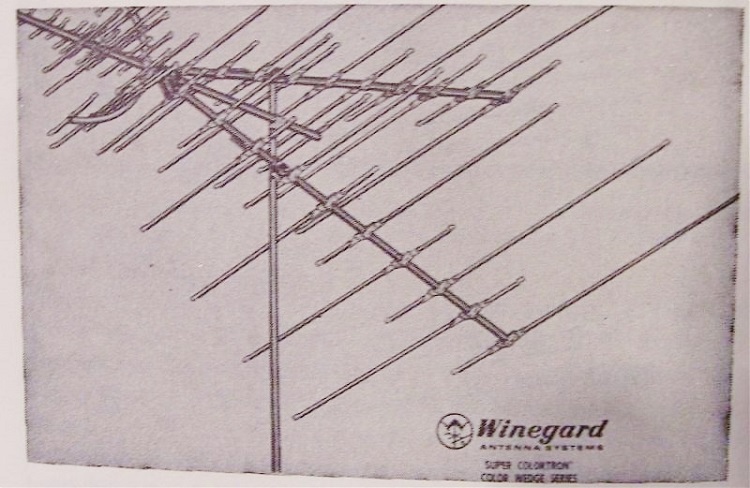
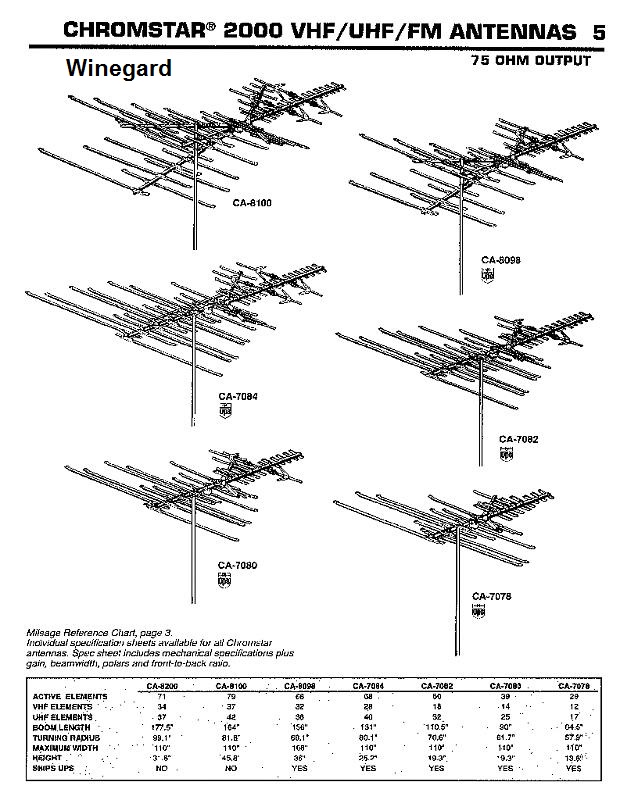
Last edited by rabbit73; 27-Mar-2019 at 8:41 PM.
|

|

|
 28-Mar-2019, 4:56 AM
28-Mar-2019, 4:56 AM
|
#8
|
|
Antenna Enthusiast
Join Date: Mar 2016
Location: Beach Park IL
Posts: 318
|
Winegard C A-8100 / H D-8100
Quote:
Originally Posted by rabbit73

OK, I think I found it.
|
Yeah, that's it! You provided the dimensions, look at the size of that thing! I take it, you never installed one Rabbit?
Later on it became the HD 8100 or something like that. It's just a big obtrusive antenna that says "if I can't get the job done nobody can". Of course it's size is mostly due to the VHF low elements I guess, so it's almost useless in today's signal environment.

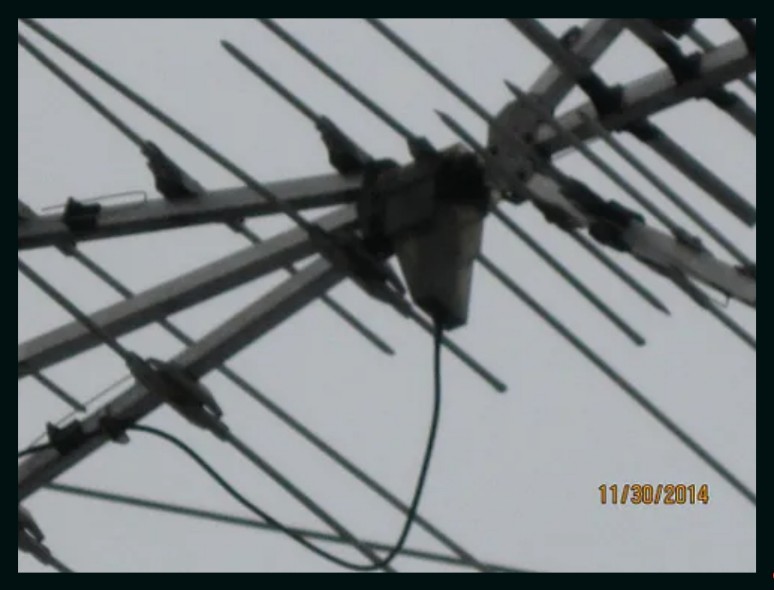
https://images.app.goo.gl/JJbuBZ3gWfGztevT9
https://images.app.goo.gl/HD9Yi8Yischu74Td8
One of my friends dad had one and he was pretty proud of it. We would go over to his house and he would rotate the HD 8100 and we'd watch it gleaming in the sunset, it was really beautiful when it was new.
When he sold the house, he left it behind. I often wanted to pick it up but it's just too much antenna for what it is capable of now. 10 to 20 years ago though I thought it must have been the ultimate. After all, bigger is better right?
I's still there but it looks like it has one of the longer elements missing now, probably still works good.
Last edited by bobsgarage; 8-Apr-2021 at 12:46 PM.
|

|

|
 28-Mar-2019, 7:05 PM
28-Mar-2019, 7:05 PM
|
#9
|
|
Retired A/V Tech
Join Date: Aug 2012
Location: S.E. VA
Posts: 2,750
|
This is another very old Winegard antenna with the wedge design that is similar:

Last edited by rabbit73; 28-Mar-2019 at 7:10 PM.
|

|

|
 29-Mar-2019, 1:39 AM
29-Mar-2019, 1:39 AM
|
#10
|
|
Antenna Enthusiast
Join Date: Mar 2016
Location: Beach Park IL
Posts: 318
|
Quote:
Originally Posted by JoeAZ

Greetings from Arizona Bob,
Combining two UHF antennas pointing in opposite directions is a
hit or miss proposition. Usually, one or more signals gets cancelled
out. Best success would be accomplished with two UHF antennas
WITH reflectors and two separate RG6 cables to each television.
Use an A/B switch or a second tuner at the televisions to watch either
Milwaukee or Chicago. We have very weak signals here, mostly translators,
at nearly 180 degrees opposite. I've yet to view any antennas with no
reflectors or two UHF antennas pointed in the opposite direction. They
just do not work that well.
|
Hi Joe, thanks for your input.
Actually I do have the setup you just described. On one Mast I have an HDB91X and a 30-2476 pointed at Milwaukee but it does have a rotator. It has a fairly clear line-of-sight other than some trees in the distance.
On the other Mast I have a XG 91 and 30 - 2476 usually pointed at Chicago. For the most part I keep them separated except for the bedroom TV I combine the signals.
As you stated I lose some of the channels. On a good signal day I can get 91 channels between both Milwaukee and Chicago. By combining antennas I'll lose the weaker channels. I get 80 or less. However there are days when the signals not so strong and I get pixelation.
What I wanted to do was get signals from both markets on one or two antennas. That's when the idea of the two 4228s came up. I know for a fact if you remove the reflectors you can get signals from both markets but the signal might be a little weaker. So then I thought about the idea of combining two 4228HDs with no reflectors.
I haven't bought anything yet. I'm just running the ideas past you guys.
Any opinions?
Last edited by bobsgarage; 30-Mar-2019 at 2:29 AM.
|

|

|
 8-Apr-2021, 1:20 PM
8-Apr-2021, 1:20 PM
|
#11
|
|
Antenna Enthusiast
Join Date: Mar 2016
Location: Beach Park IL
Posts: 318
|
The Final Solution
|

|

|
 Posting Rules
Posting Rules
|
You may not post new threads
You may not post replies
You may not post attachments
You may not edit your posts
HTML code is Off
|
|
|
|
|

